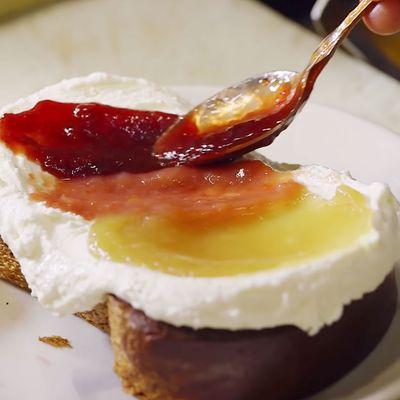
It’s difficult to overstate the influence of Sqirl, a massively popular counter-service café on the edge of Silver Lake. What started as a tiny jam business nearly a decade ago has since evolved into one of Los Angeles’ hippest brunch destinations, regularly drawing crowds of locals and visitors alike who are willing to endure interminable lines for James Beard–nominated chef Jessica Koslow’s “new California” dishes. Of all the café’s offerings, one of the most iconic (and Instagrammed) is the Famed Ricotta Toast, a hefty slab of burnt brioche that nearly buckles under an obscene amount of fresh ricotta and jam.
The New York Times has credited Koslow with building an “empire” out of artisanal, small-batch jam. But, as it turns out, that empire wasn’t entirely made out of preserved boysenberry and hibiscus and rose geranium. It was also, apparently, built on mold. At least so say a number of former Sqirl employees who recently claimed that Sqirl’s jam regularly grew thick layers of mold, which employees were instructed to scrape off the preserves before serving to unknowing customers.
Let’s unpack this nauseating drama.
What’s going on with the moldy jam?
The moldy-jam drama started to unfold over the weekend when a man named Joe Rosenthal — who describes himself as a “scientist and food antagonist” — began sharing accusations from apparent current and former Sqirl employees. According to Rosenthal’s story, Sqirl’s bulk jams — what is served at the brick-and-mortar cafe — regularly develop visible mold. “We’re talking about some buckets having like 1⁄4 inch of mold covering the entire tops of gallon buckets,” per one of the posts. Furthermore, the posts allege that Koslow instructed employees to simply remove the mold before serving the jam to customers, and that employees were “told that the health inspectors gave us permission to scoop the mold off if we went two inches down.”
And, now, a horrifying alleged visual of that mold:
Wait, why the hell was the jam moldy in the first place?
A few explanations have arisen. Per Rosenthal’s Instagram Story, many employees blame Sqirl’s preserving method, claiming that the jam was preserved incorrectly — namely, that it was “cooled in tall plastic containers rather than put in shallow hotel pans that could be cooled in an ice bath.” At least one person pointed to a moldy fan in the storage room as the offender, claiming that the fan blew spores into the uncovered buckets of jam.
And health inspectors were okay with this?
Not exactly. Employees claim that Sqirl hid the jams in an “illegal kitchen space” to avoid catching health inspectors’ eyes, and that some employees were locked in said room — which apparently also had a rat problem — during health inspections.
Some employees also say they were denied credit for their work.
According to Eater, the mold allegations came in the midst of growing backlash regarding Sqirl’s lack of diversity and role in gentrifying the neighborhood. Now, some nonwhite former employees are claiming that Koslow “took credit” for their work. Former chef de cuisine Javier Ramos posted to his Instagram account that he “didn’t get recognition or payment for the recipes that I contributed to the cookbook,” and former employee Ria Dolly Barbosa also spoke out about being denied credit for her work.
Has Sqirl responded?
A few hours after the allegations surfaced, the Sqirl Instagram account posted a lengthy response. In a series of slides, the company elaborates on how the jam came to be a hotbed for mold. The response explains that Sqirl doesn’t use commercial pectin, sweeteners, or “other stabilizers” when making jam — meaning, in comparison to most commercial jams, it’s quite low in sugar. “And put simply,” she says, “a low sugar jam is more susceptible to the growth of mold.”
Which brings us to the alleged mold problems. Whereas Sqirl’s retail jars of jam are “hot-packed in the oven” and therefore shelf stable for up to two years, according to Sqirl’s response, the bulk jam served in the café “would sometimes develop mold on the surface” because of the way it was packaged. However, the account claims that Sqirl handled any mold problem that arose with “the guidance of preservation mentors and experts like Dr. Patrick Hickey,” who reportedly instructed Sqirl to scrape off the mold.
But the company promises to do better: “In deference to the concerns about jam and mold specifically,” Sqirl says the kitchen will be implementing new packaging processes that Koslow implies will be safer. Her response did not address the allegations from former staffers that she took credit for their work.
Really? The “experts” gave mold-scraping the green light?
Well, it’s possible that someone did, somewhere along the line, but Dr. Patrick Hickey says it wasn’t him. The Washington Post called Dr. Hickey, a mycologist who specializes in mold growth and lives in Edinburgh, Scotland, to check Koslow’s facts. Per the paper, Hickey “seemed perplexed that Koslow would drop his name,” seeing as he has no memory of ever having met or even spoken to her. In 2014, he did go through a fridge with a BBC reporter to demonstrate which kinds of expired foods are okay to eat once you’ve scraped off their moldy film. In that interview, Hickey classified moldy jams as generally low-risk. Speaking to the Post, however, he clarified that he would never make that blanket recommendation for a commercial jam operation.
“There’s a danger that the toxins could build up in that jam and diffuse down deeper” than the surface, Hickey said. Also, he explained, this high-volume scraping could be hazardous to workers’ health — potentially causing infections, depending on the type of mold involved.
So should I cancel my preorder of The Sqirl Jam, Koslow’s forthcoming jam cookbook?
As, yes, that cookbook that’s coming out next week. At the very least, maybe do some light research on safe preservation methods and toss out any moldy fans you may have lying around?

